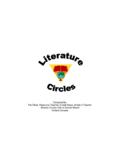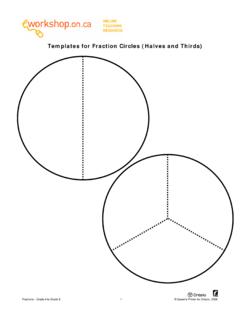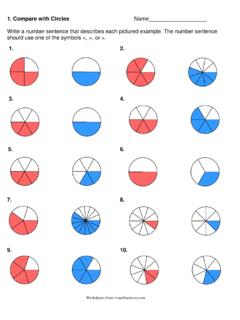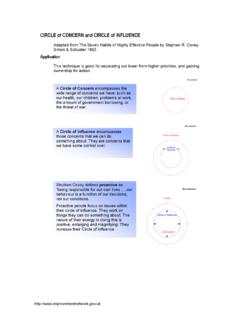Transcription of Georgia Standards of Excellence Curriculum Frameworks ...
1 Georgia Standards of Excellence Curriculum Frameworks GSE Geometry Unit 4: Circles and Volume Mathematics Georgia Department of Education Georgia Standards of Excellence Framework GSE Geometry Unit 4 Mathematics GSE Geometry Unit 4: Circles and Volume July 2018 Page 2 of 138 Unit 4 Circles and Volume Table of Contents OVERVIEW .. 3 Standards ADDRESSED IN THIS UNIT .. 3 ENDURING UNDERSTANDINGS .. 5 ESSENTIAL QUESTIONS .. 5 CONCEPTS/SKILLS TO MAINTAIN .. 5 SELECTED TERMS AND SYMBOLS .. 6 EVIDENCE OF LEARNING .. 7 FORMATIVE ASSESSMENT LESSONS (FAL) .. 7 SPOTLIGHT TASKS .. 7 TASKS .. 8 Lifting the Rope (Spotlight Task) .. 11 Circles and their Relationships among Central Angles, Arcs, and Chords .. 15 Arcs, Strings, and Radii (Spotlight Task) .. 29 Return to Lifting the Rope (Spotlight Task) .. 42 Investigating Angle Relationships in Circles.
2 46 Chords, Secants, and Tangents .. 56 Formative Assessment Lesson: Inscribing and Circumscribing Right Triangles .. 76 Formative Assessment Lesson: Geometry Problems: Circles & Triangles .. 78 Circles in Triangles (Short Cycle Task) .. 80 GRAIN STORAGE (Career and Technical Education Task) .. 82 Arc Length and Area of a Sector .. 83 Formative Assessment Lesson: Sectors of Circles .. 98 Volumes of Cylinders, Cones, Pyramids, and Spheres .. 99 Formative Assessment Lesson: Evaluating Statements about Enlargements .. 112 Formative Assessment Lesson: Calculating Volume of Compound Objects .. 114 A Golden Crown? (Short Cycle Task) .. 116 Bestsize Cans (Short Cycle Task) .. 118 Funsize Cans (Short Cycle Task) .. 120 Propane Tanks (Short Cycle Task) .. 122 Tennis Balls in a Can .. 124 Formative Assessment Lesson: 2D Representations of 3D Objects .. 127 Culminating Task: Rate of Change 135 Georgia Department of Education Georgia Standards of Excellence Framework GSE Geometry Unit 4 Mathematics GSE Geometry Unit 4: Circles and Volume July 2018 Page 3 of 138 OVERVIEW In this unit students will: Understand and Apply theorems about circles Find Arc Length and Area of Sectors of circles Explain Volume Formulas and Use them to solve problems Although the units in this instructional framework emphasize key Standards and big ideas at specific times of the year, routine topics such as estimation, mental computation, and basic computation facts should be addressed on an ongoing basis.
3 Ideas related to the eight practice Standards should be addressed constantly as well. This unit provides much needed content information and excellent learning activities. However, the intent of the framework is not to provide a comprehensive resource for the implementation of all Standards in the unit. A variety of resources should be utilized to supplement this unit. The tasks in this unit framework illustrate the types of learning activities that should be utilized from a variety of sources. To assure that this unit is taught with the appropriate emphasis, depth, and rigor, it is important that the Strategies for Teaching and Learning in the Comprehensive Course Overview and the tasks listed under Evidence of Learning be reviewed early in the planning process. Standards ADDRESSED IN THIS UNIT Mathematical Standards are interwoven and should be addressed throughout the year in as many different units and activities as possible in order to emphasize the natural connections that exist among mathematical topics.
4 KEY Standards Understand and apply theorems about circles Understand that all circles are similar. Identify and describe relationships among inscribed angles, radii, chords, tangents, and secants. Include the relationship between central, inscribed, and circumscribed angles; inscribed angles on a diameter are right angles; the radius of a circle is perpendicular to the tangent where the radius intersects the circle . Construct the inscribed and circumscribed circles of a triangle, and prove properties of angles for a quadrilateral inscribed in a circle . Construct a tangent line from a point outside a given circle to the circle . Georgia Department of Education Georgia Standards of Excellence Framework GSE Geometry Unit 4 Mathematics GSE Geometry Unit 4: Circles and Volume July 2018 Page 4 of 138 Find arc lengths and areas of sectors of circles Derive using similarity the fact that the length of the arc intercepted by an angle is proportional to the radius, and define the radian measure of the angle as the constant of proportionality; derive the formula for the area of a sector.
5 Explain volume formulas and use them to solve problems Give informal arguments for geometric formulas. a. Give informal arguments for the formulas of the circumference of a circle and area of a circle using dissection arguments and informal limit arguments. b. Give informal arguments for the formula of the volume of a cylinder, pyramid, and cone using Cavalieri s principle. Give an informal argument using Cavalieri s principle for the formulas for the volume of a sphere and other solid figures. Use volume formulas for cylinders, pyramids, cones, and spheres to solve problems. Visualize relationships between two-dimensional and three-dimensional objects Identify the shapes of two-dimensional cross-sections of three-dimensional objects, and identify three-dimensional objects generated by rotations of two-dimensional objects. Standards FOR MATHEMATICAL PRACTICE Refer to the Comprehensive Course Overview for more detailed information about the Standards for Mathematical Practice.
6 1. Make sense of problems and persevere in solving them. 2. Reason abstractly and quantitatively. 3. Construct viable arguments and critique the reasoning of others. 4. Model with mathematics. 5. Use appropriate tools strategically. 6. Attend to precision. 7. Look for and make use of structure. 8. Look for and express regularity in repeated reasoning. SMP = Standards for Mathematical Practice Georgia Department of Education Georgia Standards of Excellence Framework GSE Geometry Unit 4 Mathematics GSE Geometry Unit 4: Circles and Volume July 2018 Page 5 of 138 ENDURING UNDERSTANDINGS Understand and Apply Theorems about Circles Find Arc Lengths and Areas of Sectors of Circles Explain Volume Formulas and Use them to solve problems Extend the study of identifying cross sections of three dimensional shapes to identifying solids of revolution ESSENTIAL QUESTIONS How are Congruent Chords related?
7 How does the GBI use the fact that the perpendicular bisectors of the sides of a triangle are concurrent to solve crimes? How does the location of the vertex of an angle effect the formula for finding the angle measure? When two lines intersect they create an angle. How does the location of the vertex of that angle effect the formula that I will use to find the lengths of those line segments that get created? What are some real life examples of lines intersecting circles and will I be able to solve them? Where is Arc Length on a cookie? Where is a Sector on a cookie? How did ancient mathematicians construct perfect tangents to a circle , without the software or measuring tools that we have today? How does Cavalieri s Principle apply to finding the Volume of a cylinder, even if it is oblique or not standing straight up? How can you identify the resulting solid of revolution when the graph of a simple function is rotated around an axis?
8 CONCEPTS/SKILLS TO MAINTAIN The introduction to all of the parts of a circle and the relationships of all of those parts to each other will be new to students this year. The concepts of Area, Surface Area, and Volume of triangles, special quadrilaterals, and right rectangular prisms were introduced in the 6th Grade Unit 5. This knowledge was built on in the 7th Grade Unit 5 and expanded to include the slicing of right rectangular pyramids. The Volumes of Cones, Cylinders, and Spheres were previously covered in the 8th Grade Unit 3. The purpose of re-visiting these formulas here in Analytic Geometry is to formalize the students understanding of the development of these formulas; to take them from a memorization and use of the formulas to an understanding and application level. Georgia Department of Education Georgia Standards of Excellence Framework GSE Geometry Unit 4 Mathematics GSE Geometry Unit 4: Circles and Volume July 2018 Page 6 of 138 SELECTED TERMS AND SYMBOLS Arc: an unbroken part of a circle ; minor arcs have a measure less than 1800; semi-circles are arcs that measure exactly 1800; major arcs have a measure greater than 1800 Arc Length: a portion of the circumference of the circle Arc Measure: The angle that an arc makes at the center of the circle of which it is a part.
9 Cavalieri s Principle: A method, with formula given below, of finding the volume of any solid for which cross-sections by parallel planes have equal areas. This includes, but is not limited to, cylinders and prisms. Formula: Volume = Bh, where B is the area of a cross-section and h is the height of the solid. Central Angle: an angle whose vertex is at the center of a circle Chord: a segment whose endpoints are on a circle Circumcenter: The point of intersection of the perpendicular bisectors of the sides of a given triangle; the center of the circle circumscribed about a given triangle. Circumscribed circle : a circle containing an inscribed polygon; for this unit the polygon will be a triangle and so the center of the circle will be the circumcenter of the triangle. Composite Figures: If a figure is made from two or more geometric figures, then it is called a Composite Figure.
10 Inscribed: an inscribed planar shape or solid is one that is enclosed by and "fits snugly" inside another geometric shape or solid. Inscribed Angle: an angle whose vertex is on the circle and whose sides contain chords of a circle Inscribed circle : a circle enclosed in a polygon, where every side of the polygon is a tangent to the circle ; specifically for this unit the polygon will be a triangle and so the center of the Inscribed circle is the incenter of the triangle Inscribed Polygon: a polygon whose vertices all lie on a circle Lateral Area: The sum of the areas of the lateral (vertical) faces of a cylinder, cone, frustum or the like. Major and Minor Arcs: Given two points on a circle , the minor arc is the shortest arc linking them. The major arc is the longest. Point of Tangency: the point where a tangent line touches a circle . Secant Line: a line in the plane of a circle that intersects a circle at exactly two points Secant Segment: a segment that contains a chord of a circle and has exactly one endpoint outside of the circle Sector: the region bounded by two radii of the circle and their intercepted arc Slant Height: The diagonal distance from the apex of a right circular cone or a right regular pyramid to the base.

















